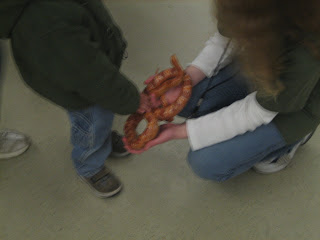
I posted a couple of weeks ago about
the possibility of the D.B. Cooper mystery being solved. A few days after that, the verdict was in-- the parachute that was found was definitely not one of the parachutes that the authorities gave to "Cooper" during the hijacking. The parachute that the kids found was a World War II vintage silk parachute. The parachutes that were given to Cooper were nylon chutes that were relatively new at the time (1971).
The other night, though, I was thinking: where the hell, then, did the silk parachute come from? It occurred to me that the purpose of the chutes may not have been for his use. His hijacking was meticulously planned. I have trouble believing that he'd have counted on getting the parachutes after the hijacking started. My thought was, then, that the chutes he asked for were red herrings-- that he carried a chute-- which he purchased from an Army Surplus store-- with him onto the flight (remember that in these days, there was virtually no inspection of carry-on luggage-- it was his hijacking that changed that).
Whatever the case may be, the mystery of D.B. Cooper. like
The Dude, abides.

Another mystery, however, is coming to light: why the Titanic sank. That is, other than the Captain being pressured to go too fast and run the Titanic through a dangerous icefield quickly.
Scientists are testing rivets taken up from the Titanic wreck and discovering that first, the rivets used were not of the highest quality.
http://www.nytimes.com/2008/04/15/science/15titanic.htmlThe rivets contained large amounts of slag, which made them much more brittle, particularly as they got colder. Given that the Titanic was going to spend her whole working life in the frigid North Atlantic, that is something the company might have wanted to consider.
If there had been less damage, the ship may have lasted longer; the assumption was that even if she'd been mortally damaged, she would survive long enough for help to get there. Indeeed, if she'd stayed partly afloat for less than two hours more, virtually every passenger and crew member would have been saved.
The reason for the use of the inferior metal, it appears, is that there was a shortage of the top quality metal (as well as riveters). The company was trying to complete three huge ships at one time. And there were some money issues. Surprise, surprise.
There is a long and rich history of companies cutting corners to save money. A couple I have personal connections with.

On May 25, 1979, I was a senior at Lyons Township High School, getting ready to graduate in less than two weeks. I was riding my bike home from school when I noticed a lot of smoke to the north. When I got home, I turned on the television to see what was going on and discovered that a plane had crashed at O'Hare Airport-- American Airlines Flight 191.
It turned out, as investigations showed, that mechanics had been taking a shortcut during routine engine maintainence. Rather than taking the engine off first, then the pylon that it was attached to the wing with, they were detaching the whole thing at once. Over time it cracked the rods that held the pylon to the wing. As Flight 191 went up, the cracked pins snapped and the engine came completely off, pulling out vital hydraulic lines with it. The pilot was unable to regain control and the airplane slammed into the ground, as the horrifying picture that someone in O'Hare snapped showed.
My father was an instructor at IBM back then. One of the other instructors in his group had, that day, had a group that he kept past the normal class time. Because of it, they missed their flight back to Los Angeles. They were supposed to be on Flight 191.

Around that time, my family had two cars. One of them was a 1973 Ford Pinto. In the late seventies, there was a recall for the Pintos. It seemed that if they were struck from behind, the tube leading from the gas tank to the fill-up spout would tear loose and pour gasoline on the pavement.

As this happened, the leaf springs would tear loose at the end toward the end of the car and strike the pavement like a flint, often igniting the gasoline. This was responsible for a number of accidents, including a horrific accident in Indiana in which three teenaged girls were killed and one left horribly burned. This resulted in a personal injury award that set a record the time.
One day, my father asked me to take the Pinto to a nearby mechanic to get an estimate on the "fix" that Ford was paying for. The mechanic showed me a Pinto in the back that had suffered a year-end collision, and why the accidents were so bad, and demonstrated just what the fix would entail-- a piece of plastic under the gas tank that would allow the gas to pour a few inches further back.
Very reassuring. From then on, I kept my eye on the rear view mirror whenever I was at a stoplight.

Later, when I was talking about it to my father, I was thinking of another recall-- around the same time, the Firestone company was recalling their Firestone 500 radials, which would overheat and fly apart at certain speeds. I joked with him-- wouldn't it have been ironic if our Pinto had come equipped with Firestone 500 radials?
It had, he told me. The tires ahd been replaced a couple of years before, when the treads wore out.
I didn't know whether to laugh or cry.
 The prevailing Yen family belief is that of our two resident cats, Fatboy is the less smart. So when Kim bought a bed for the cats, and they decided that my backpack and other less comfortable things were better places to rest, we began to wonder which one of them was going to figure out that the bed was more comfortable than a bag with books and pens in it.
The prevailing Yen family belief is that of our two resident cats, Fatboy is the less smart. So when Kim bought a bed for the cats, and they decided that my backpack and other less comfortable things were better places to rest, we began to wonder which one of them was going to figure out that the bed was more comfortable than a bag with books and pens in it. 



















































